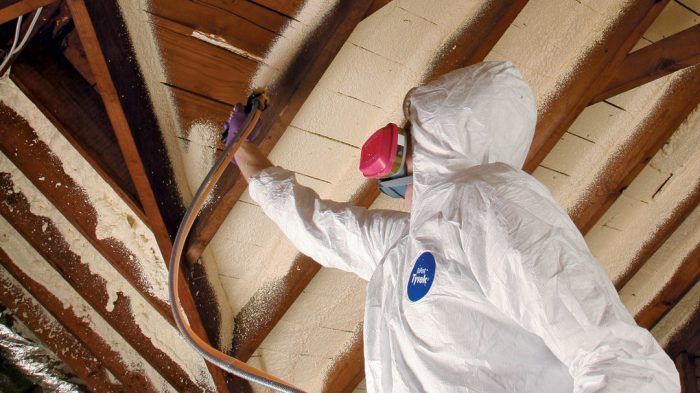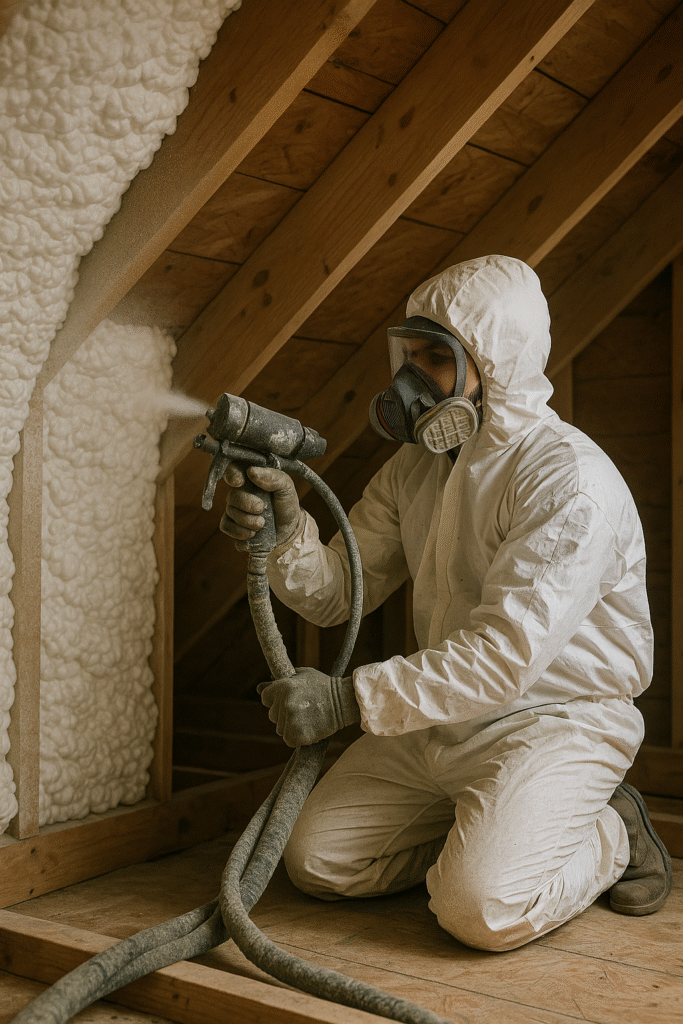The Future of Energy Efficiency Starts Here
Spray foam insulation isn’t just for construction nerds or eco-warriors — it’s for anyone who wants a home or building that’s quieter, more comfortable, and drastically cheaper to heat and cool. Whether you’re upgrading your home, planning a renovation, or curious about energy-saving solutions, understanding spray foam insulation might just change the way you think about your space.
Understanding Spray Foam Insulation
Spray foam insulation is a modern, high-performance material made by mixing two chemicals — isocyanate and polyol resin — that react to create a foam. This foam rapidly expands on contact, filling cracks, gaps, and cavities to form a durable barrier that resists heat flow and air infiltration.
There are two primary types:

- Open-cell spray foam: Light, flexible, and spongy, this version is ideal for interior use. It provides strong sound absorption and a lower R-value (insulating power) per inch.
- Closed-cell spray foam: Dense and rigid, it offers a higher R-value and acts as a vapor barrier. It’s commonly used for exterior walls, basements, and roofs.
“Think of it as insulation and sealant in one. It’s not just a filler — it’s a complete envelope,” explains Tom Keller, a certified energy auditor.
Common Uses in Residential and Commercial Spaces

Spray foam insulation is one of the most versatile insulation materials on the market. It can be applied to:
- Attics and lofts
- Interior and exterior walls
- Basement and crawl spaces
- Garage ceilings
- Roofs and underflooring
- Gaps around windows, doors, and pipes
Its ability to mold to any shape makes it perfect for irregular spaces and hard-to-reach areas — something traditional batts or rolls just can’t achieve.
Spray Foam vs Traditional Insulation: A Clear Winner?
Let’s break it down:
- R-Value (per inch)
- Spray Foam: High (6–7)
- Fiberglass/Cellulose: Medium (2.2–3.8)
- Air Sealing
- Spray Foam: Excellent
- Fiberglass/Cellulose: Poor
- Moisture Resistance
- Spray Foam: High (especially closed-cell)
- Fiberglass/Cellulose: Low
- Longevity
- Spray Foam: Lasts for decades without settling
- Fiberglass/Cellulose: May sag or settle over time
- Soundproofing
- Spray Foam: High (notably with open-cell)
- Fiberglass/Cellulose: Moderate
- Installation
- Spray Foam: Requires professional installation
- Fiberglass/Cellulose: DIY-friendly
Spray foam acts like a thermal jacket for your building. It blocks not only heat but also air and moisture, making it a triple-threat in building science.
Benefits That Go Beyond Comfort
So why should the average homeowner or builder care? Because the advantages are measurable — and meaningful.
- Lower Utility Bills: Energy savings of 20–50% are common thanks to superior sealing and insulating properties.
- Better Indoor Air Quality: By reducing air leaks, it helps keep allergens, dust, and pollutants out.
- Mold Prevention: Closed-cell foam resists moisture, which deters mold growth.
- Noise Reduction: Especially with open-cell spray foam in walls and ceilings.
- Increased Structural Strength: Closed-cell foam adds rigidity to walls and roofs.
- Sustainable Living: Reduced energy use = lower carbon footprint.
“We started saving over $100/month on our utility bill after switching to spray foam,” says homeowner Maria Thompson. “And our home is noticeably quieter too.”
The Installation Process: Step by Step
Spray foam insulation should always be handled by trained professionals due to chemical exposure risks and the need for precision. Here’s what to expect:
- Consultation & Quote: A contractor assesses your property and suggests appropriate solutions.
- Prep Work: Surfaces are cleaned, and areas are masked off.
- Application: Using a spray rig, the foam is applied in layers and left to expand and cure.
- Curing Time: The foam hardens in minutes, but the space may require ventilation for 24–72 hours.
- Final Inspection: Technicians inspect for proper coverage and sealing.
Safety Tip: Occupants should vacate during installation and curing. Proper ventilation and PPE are critical during this process.
Things to Consider Before You Commit
While spray foam offers significant advantages, it’s not a one-size-fits-all solution. Consider the following before moving forward:
- Cost: Expect to pay $1.50–$3.00 per square foot for open-cell and $3.00–$6.00 for closed-cell — higher than traditional methods, but often recouped in savings.
- Retrofits May Require Demo: Installing in existing walls can be tricky without drywall removal.
- Not Always Eco-Friendly: Some foams use chemical blowing agents; ask about low-GWP (Global Warming Potential) options.
- Professional Installation Required: DIY kits exist, but most experts advise against them due to safety and quality risks.
A Smart Investment for Homeowners and Builders Alike
When you factor in energy savings, improved comfort, better air quality, and long-term durability, spray foam insulation becomes more than a trend — it’s a long-term solution for a sustainable, efficient, and livable space.
Whether you’re designing your dream home or upgrading an older one, spray foam can dramatically change how your property performs year-round.
“Insulation is one of the few upgrades that pays for itself — and spray foam does it faster than most,” notes building contractor James Ellis.




